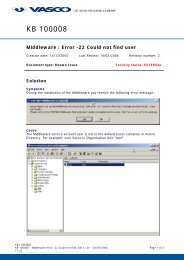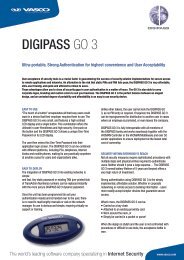DIGIPASS Authentication for FortiGate VPN SSL IDENTIKEY - Vasco
DIGIPASS Authentication for FortiGate VPN SSL IDENTIKEY - Vasco
DIGIPASS Authentication for FortiGate VPN SSL IDENTIKEY - Vasco
You also want an ePaper? Increase the reach of your titles
YUMPU automatically turns print PDFs into web optimized ePapers that Google loves.
<strong>DIGIPASS</strong> <strong>Authentication</strong> <strong>for</strong> Fortigate <strong>SSL</strong>-<strong>VPN</strong><br />
Fill in a policy ID and description. Choose the option most suitable in your situation. If you want<br />
the policy to inherit setting from another policy, choose the right policy in the Inherits From list.<br />
Otherwise leave this field to None.<br />
Figure 11: Policy configuration (2)<br />
In the policy options configure it to use the right back-end server. This could be the local<br />
database, but also active directory or another radius server.<br />
This is probably the same that was in your default client authentication options be<strong>for</strong>e you<br />
changed it. Or you use the local database, Windows or you go further to another radius server.<br />
In our example we select our newly made Demo Policy and change it like this:<br />
Local auth.: Digipass/Password<br />
Back-End Auth.: Default (None)<br />
Back-End Protocol: Default (None)<br />
Dynamic User Registration: Default (No)<br />
Password Autolearn: Default (No)<br />
Stored Password Proxy: Default (No)<br />
Windows Group Check: Default (No Check)<br />
After configuring this Policy, the authentication will happen locally in the <strong>IDENTIKEY</strong> Server. So<br />
user credentials are passed through to the <strong>IDENTIKEY</strong> Server, it will check these credentials to its<br />
local user database and will answer to the client with an Access-Accept or Access-Reject<br />
message.<br />
14 <strong>DIGIPASS</strong> <strong>Authentication</strong> <strong>for</strong> Fortigate <strong>SSL</strong>-<strong>VPN</strong>










![KB [100006] - Vasco](https://img.yumpu.com/12539350/1/184x260/kb-100006-vasco.jpg?quality=85)






